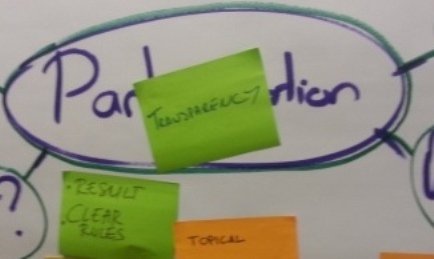Participation Success Factors: a quick followup

Imported from the Blogactiv.eu blogging platform, closed without warning in 2021. Links, images and embeds not guaranteed, and comments not displayed.
What happened when 60 odd people had a go at the Participation mindmap?
The EuroPCom session went well yesterday, judging by the Tweets. I'd never even been to an event run on World Café lines, so thank goodness the others knew what they were doing.
Original link
In the end the mindmap - which started out as a throwaway idea, a prop to get people started - turned out to be quite central, with each table of 5 people adding their 3 'top factors' for participation success onto a shared mindmap stuck to the wall.
The result looked like this:
So I've gone back to my MindMeister file and updated it with the group's thoughts:
Original link
The nodes marked yellow and the connectors in red were added to the mindmap by session participants using Post-Its.
(Click to enlarge, view the Mindmeister file or view a 'before and after' comparison on my TumblrHub.) For me, the key things that emerged were:
Who? and Why? are truly the same question
Most Post-its placed on the right side of the mindmap concerned not just who the audience were, but why they would be interested, and so could have been out either alongside Who? or Why?
The bottom line is that your project needs a one sentence mission statement which sets out Who your audience is, Why you want their input and Why they would want to give it to you.
Avoiding 'cosmetic' participation
I got my best laughs with my "no-one goes to an event to have their awareness raised" line. I was actually half-expecting an uncomfortable silence.
But if one issue emerged from practically every group, it was the nature of the promise that a participation policy must make to its potential users that their input will be actually used. The key factors raised during the session were avoiding over-promising and being trustworthy, credible and clear on the processes involved.
This is particularly problematic for 'wide audience' participation on EU levels, due to the problem of scale. So we had a good discussion about projects which confuse 'participation' with 'communications'. Participation projects need communications, and moreover are good to communicate - the inherent message is positive and has several in-built Call to Action, one of which is 'Share!'.
But a communications project which masquerades as a participation project will fail at both, generating only bad publicity and poisoning the well with distrust and cynicism. In this context I learnt a new word: 'democracy-washing', based on greenwashing. I wished I'd known it when I was writing the “We’ll pretend to listen“ anecdote in Dialogue of the deaf: interpreting the election results.
We added How...
The mindmap was designed to get people started by focusing on the key questions regarding project conception, but some groups went further and identified key issues concerning How it should be done. The overwhelming message that emerged was KISS (Keep It Simple, Stupid).
... but never got to When?
However, we never got to the last question - When? - ironically due to lack of time. A shame, because most people in this field are still thinking about 'participation projects' which have beginnings, middles and ends.
True participation is ongoing, but not (IMHO) continuous. You need phases and milestones, where results are processed and results published, because you need to show concrete results emerging from people's contributions, rather than simply providing a Black Hole marked 'Suggestions'. But that is a milestone, not the 'end' of the participation. It should mark the launch of a new phase.
Transparency = Sustainable Participation
Hence the location of 'Transparency':
Original link
This was placed in the centre of the mindmap by David Worsell, Director of @GovDeliveryUK:
Sorry for lack of tweets. I've been too busy participating in a proper session at #EuroPCom thanks @demsoc @mathewlowry — David Worsell (@dworsell) October 15, 2014
Transparency makes you automatically credible and trustworthy - people can see what you're doing, and how you came to your conclusions, at each phase of participation. Crucially, this ensures you don't lose your credibility, even amongst participants disappointed with the outcome.
Because they can see how you got there, they'll respect and trust your process, and so will probably come back in the next phase. Contrast that with the natural reaction of someone who didn't get their way from an untransparent process: "They clearly didn't listen to me. They must have been faking it. B*stards."
Participation is not a project that you turn on and off when you want to get some traction on social media. It's a style of government, and needs a transparent environment to survive.
---
Relevant reading
- What are the top Success Factors for EU eParticipation?
- Dialogue of the deaf: interpreting the election results
- Building Communities of Practice with Event-in-a-Box
- #euco: damn, maybe we didn’t get through 2010 unscathed after all
- Can EU social media scale to the EU?
See also: (handling) comments, community, online community management on my TumblrHub public library.
Related reading
More Stuff I Think
More Stuff tagged community , transparency , trust , europcom , social media , participation
See also: Communication Strategy , Online Strategy , Online Community Management , Social Media Strategy , Content Creation & Marketing , Social Web , Politics , Communications Strategy